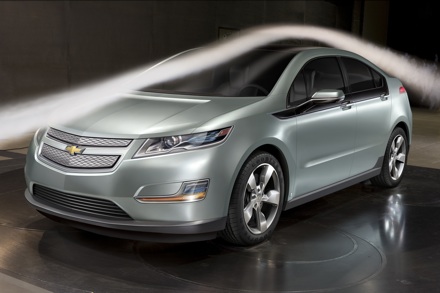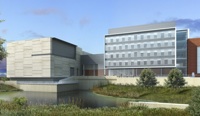
Where Science Hits the Road
By Mike McLeod
General Automotive ACE Research UOIT wind tunnelGM’s Automotive Center of Excellence set to transform Southern Ontario into haven of automotive research.

No matter how far computer-based analysis may advance, there’s no substitute for real world product testing. Fact is, there’s no way to anticipate and virtually simulate all the circumstances that may cause a mechanical/electrical system to perform to spec in dry Arizona heat yet fail in the cold and damp of a Manitoba winter.
However, subjecting a prototype to every environmental condition prior to launch, especially a product as complex as a car, is often economically impractical if not impossible. Only a handful of OEMs have the resources to finance automotive proving grounds in “extreme” locations.
Although such conditions can be replicated in environmental chambers and/or wind tunnels, many such North American facilities are either privately owned, narrowly designed to test a specific vehicle class or perform only a limited battery of tests. Consequently, most automotive manufacturers, suppliers and researchers have few options to perform comprehensive testing.
Enter the General Motors of Canada Automotive Centre of Excellence (ACE) presently under construction in Oshawa on the University of Ontario Institute of Technology (UOIT) campus. Scheduled to open in January 2011, the multi-level, 16,300-square-metre facility will offer a comprehensive range testing capabilities including one of the largest and most sophisticated climactic wind tunnels available anywhere.
“There are only a few facilities in the world like ACE, but they aren’t as unique,” says John Komar, director of engineering and operations for ACE. “Fundamentally, they are just wind tunnels and not full research facilities with heavy lab areas, four-post shakers and garage bays, as well as environmental and anechoic chambers. Combine that with the opportunity to collaborate with top researchers from the university and you have a one-stop-shop for automotive research.”
Announced in 2005, ACE grew out of General Motor’s Beacon Project, a CAD$2.5-billion reinvestment in the automaker’s Canadian operations and the largest automotive investment in Canadian history. As part of Beacon, GM, the government of Canada, the Province of Ontario and UOIT conceived ACE as the cornerstone of a broader Canadian Automotive Innovation Network comprised of universities in Ontario, Quebec and British Columbia. Although ACE carries GM’s name and has signed the automaker as anchor tenant, Komar says the facility will be operated independently, making it available to any and all Canadian and international manufacturers, start-up companies and researchers.
“Now, manufacturers of any size can play in the same sandbox as the big players without having to make a huge capital investment,” he adds. “Of course, automotive development is one of the core mandates of the facility, but it isn’t restricted to that. It can be used for any kind of development where you simply want to make sure your product is going to hold up.”
Christmas in July
When construction completes later this year, ACE will be comprised of two main facilities. Half the complex will be a five-story integrated research and training building, complete with offices, laboratories and common work areas. However, it’s ACE’s core research facility, and return-flow climactic wind tunnel (CWT) at its heart, that’s already garnering international attention.
Capable of generating wind speeds in excess of 240 km/h, the CWT’s most attractive feature will be its broad range of climactic simulation capabilities. In addition to producing humidity between five to 95 percent, the CWT’s test chamber is equipped with overhead and forward facing snow guns to generate blizzard conditions down to -40ºC and a 12-nozzle rain system to replicate anything from a common downpour to freezing rain. For the opposite extreme, banks of metal halide solar arrays with automatic azimuth, altitude and intensity control will provide researchers with simulated sunrise to sunset exposure and desert heat up to 60ºC.
“Our climactic wind tunnel can create snow storms in July and desert heat in February,” Komar says. “That can be critical for OEM’s looking to compress their development cycles yet still perform comprehensive design validation.”
Also central to CWT’s singular status in the industry will be its 4-wheel independent chassis dynamometer, which provides vehicle road load. In combination with the chamber’s climactic controls, the dynamometer will be capable of putting vehicles through extreme conditions, such as pulling a trailer uphill in desert heat or downhill during a snow storm. In addition, the unit sits within an 11-meter diameter turn table and is suspended on six large air bearings, which allow test vehicles to smoothly yaw ± 30 degrees to simulate cross winds.
While either the CWT’s climactic controls or its chassis dynamometer would make ACE’s facilities uncommon, possibly its most distinctive feature is its variable nozzle—the structure that shapes the wind stream as it passes into the test chamber. Typically, wind tunnel nozzles are static, but ACE’s can expand from 7m2 to over 13m2, allowing it to test a broad range of vehicle sizes.
“The one-two punch that makes ACE the most unique climactic wind tunnel on the planet is its indexing dynamometer along with a large test space and the variable nozzle,” Komar says. “The combination provides absolute flexibility such that we can do development for a bus company one shift and a small electric A-sized vehicle on the next.”
Shake and Bake
For researchers who don’t require aerodynamic analysis, the core research facility houses two additional climactic chambers or “soak rooms”, the larger of which can accommodate a standard bus or three large SUVs and is equipped with its own 4WD eddy-current dynamometer. Both static cells will be able to perform tests such as cold start, extended idles and hot soaks under controlled temperature and humidity conditions.
In addition, the core facility houses a 4500kg-rated, 4-post hydraulic vehicle shaker to simulate everything from minor road vibrations to hitting pot-holes at high speed. With it, researchers will be able to test vehicles for production quality, ride comfort and structural durability. Lastly, a semi-anechoic chamber equipped with a 2-meter, 6 DOF Multi-Axis Shaker Table (MAST) will provide durability, climactic and acoustical testing on a smaller scale.
“All the walls are sound proofed,” Komar says, “so any squeak, rattle, or vibration harmonics could be picked up through instrumentation, accelerometers or simple microphones. You could also put a flight simulator in there or you might be a consumer electronics company and you want to make sure your latest product will survive five years of rough handling.”
Beyond the immediate benefits for UOIT and North American manufacturers, Komar says ACE is the cornerstone of far sighted strategy, one that may transform the region into the Silicon Valley of automotive research. “For Southern Ontario, ACE will mean that you can get development done without having to cross a border; you can transfer your virtual engineering ideas into physical and still be home for dinner,” he says. “In the longer term, it also provides the kind of infrastructure that attracts high-tech, knowledge-based industry to the region. Eventually, the hope is Oshawa and the GTA will become a focus of manufacturing innovation for North America.” DE
www.ace.uoit.ca

